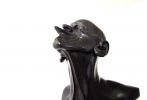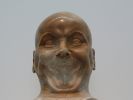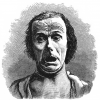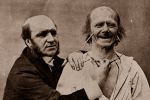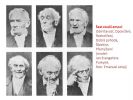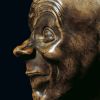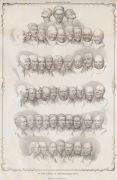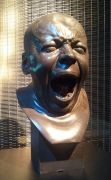Photographs of Messerschmidt's Grimaces were displayed in the convent and, together with Athanasius Kircher, those bizarre portraits became a trademark and inspiration for the symposium.
Franz Xaver Messerschmidt (born 1736 in Weisensteig, died 1783 in Bratislava) was a German-Austrian Baroque sculptor. He is famous for his late works, called "character heads," or "grimaces" which were made in his Bratislava seclusion, where he spent his last years. In 1781, German author Friedrich Nicolai visited Messerschmidt at his studio in Bratislava/Pressburg and subsequently published a transcript of their conversation (Friedrich Nicolai, Description of a Journey Through Germany and Switzerland, written in the year 1781). Nicolai's account of the meeting is interpreted as a valuable resource, because it is the only contemporary document that details Messerschmidt's reasoning behind the execution of his "character heads." Nicolai claims that for many years Messerschmidt had been suffering from an undiagnosed digestive complaint, now believed to be Crohn's disease, which caused him considerable discomfort. In order to focus his thoughts away from his condition, Messerschmidt devised a series of pinches he administered to his right lower lip. Observing the resulting facial expressions in a mirror, Messerschmidt then set about recording them in marble and bronze. His intention, he told Nicolai, was to represent the 64 "canonical grimaces" of the human face using himself as a template.
During the course of the discussion, Messerschmidt went on to explain his interest in necromancy and the arcane, and how this also inspired his character heads. Messerschmidt was a keen disciple of Hermes Trismegistus (Nicolai noted that among the few possessions that littered Messerschmidt's workshop was a copy of an illustration featuring Trismegistus: "Aside from that there was a drawing of an Egyptian statue without arms on half a sheet of paper hanging near the window. He never looked at this drawing without reverence and awe".) and abided by his teachings regarding the pursuit of "universal balance" (a forerunner to the principle of the Golden Ratio). As a result, Messerschmidt claimed that his character heads had aroused the anger of "the Spirit of Proportion," an ancient being who safe-guarded this knowledge. The spirit visited him at night, and forced him to endure humiliating tortures. One of Messerschmidt's most famous heads, The Beaked, was supposedly inspired by one of these encounters with spirits. ("In Vienna he fell into the company of some people who boasted secret knowledge of dealings with invisible spirits and the mastery over the forces of nature. These kinds of people are very prolific in Europe and especially when operating in Germany they cripple the minds of a great many and exercise power over them in the employ of others, of people behind the scenes for whom such stupid activities are quite convenient," Friedrich Nicolai).
In his analysis of the work, art historian Ernst Kris was forced to replace the expressionistic method of empathy with the evenly-suspended attention of psychoanalysis, equally turned to artistic and biographical material. In the first version of the essay (published in 1932), Ernst Kris discussed the complete work of Messerschmidt in historical, stylistic and theoretical terms. According to Kris, character heads and late portrait busts were partly based on physiognomical interests and comparisons between humans and animals in the manner of Della Porta and of Charles Le Brun's illustrations for his Traité sur les passions.
see: Ulrich Pfarr: Ernst Kris on F. X. Messerschmidt--A Valuable Stimulus for New Research?, American Imago 58.1 (2001) 445-461
Another famous researcher engaged in facial expressions was Duchenne de Boulogne (1806—1875), a French neurologist. He described several nervous and muscular disorders and, in developing medical treatment for them, created electrodiagnosis and electrotherapy. During his lifelong private practice in Boulogne (1831–42) and in Paris (1842–75), he explored the effects of electrical stimulation on diseased nerves and muscles. He rendered the first accounts of several types of muscular atrophy and paralysis caused by nerve disorders, including tables dorsalis, or locomotor ataxia, a muscular atrophy caused by a degeneration of the dorsal columns of the spinal cord and sensory nerve trunks. In the 1860s he described severe progressive muscle weakness in 13 young boys, a condition that was later named Duchenne muscular dystrophy. His invention of an instrument (Duchenne’s trocar) to remove small portions of tissue located deep in the body founded the diagnostic practice of biopsy. His best-known writings are De l’électrisation localisée (1855) and Physiologie des mouvements (1867).
Austrian artist Arnulf Rainer placed his own scribbles in oil over photographs of 19th-century plaster-cast reproductions of eight of Messerschmidt's Character Heads—an overt statement of the contemporary artist's enthusiasm for the 18th-century sculptor's oeuvre. Rainer called these images "conversations," through which he engaged directly with Messerschmidt's work.


